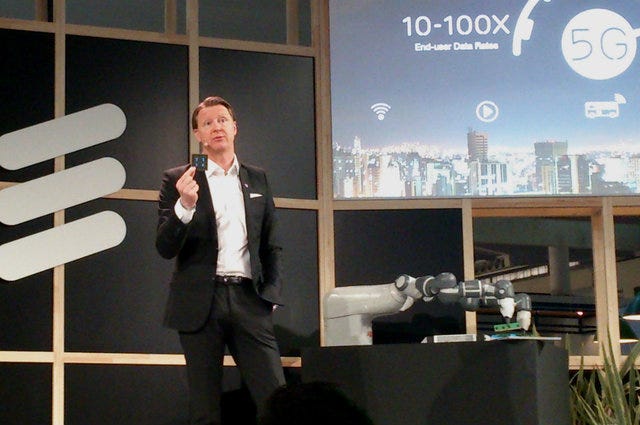5G Networks Getting Closer
Hopes run high for 5G at Mobile World Congress as the industry awaits a standard for the emerging technology.
February 29, 2016

As expected, 5G was one of the main topics of discussion during Mobile World Congress (MWC) this year. Several companies had prototypes showing significant advances on the path to standardization and visitors could see working test beds showcasing 5G’s potential power and speed.
Most of the 5G technologies displayed at MWC used millimeter wave bands, including bands in the Federal Communications Commission's “Notice for Proposed Rulemaking for 5G Spectrum” and the EU’s “5G-PPP Pre-standards-WG Issues” paper.
The one point that most industry stakeholders agree on, as they confirmed in several sessions during MWC, is that 5G is not a technology for people’s handsets, but rather a way to connect the 20+ billion devices projected by 2021. 5G technology is necessary to support the exponential growth of data traffic expected to increase ten-fold in the next five years.
“5G…is not only about more speed and more bandwidth for mobile, but about building the communication platform that will power the digital revolution,” European Commissioner for Digital Agenda Günther Oettinger said during a press conference on the 5G PPP. “This means that public services, utilities, manufacturing, healthcare, and farming will all be using 5G networks to deliver new, smart products and services based on next generation connectivity.”
Collaboration was the most repeated word in every 5G event, keynote and presentation. Everyone in the industry seemed to agree that without the involvement and cooperation of all stakeholders, including vendors, carriers, governments, industry consortiums, and Internet companies, it wouldn’t be possible to introduce 5G on time and have a clear standard by 2020.
There is already competition between vendors and operators, but for the moment the “love cards” continue to circulate, as Ericsson CTO Ulf Ewaldsson put it. “It is a little bit like Valentine’s day in the United States, where everybody sends each other love cards. And all the vendors and operators are sending love cards to each other,” he said in one of his presentations.
Swedish manufacturer Ericsson made 5G the big theme of its MWC presence this year, once again having the biggest booth in the whole show. Regarding the race to launch services, Ericsson President and CEO Hans Vestberg said that there will be pre-standard 5G networks before 2020, and that the industry expects to have over 150 million 5G subscribers by 2020.
The challenges are astonishing, he said, citing getting below 5ms latency, supporting 100 times more devices and 1,000 times more data, and enabling batteries to last for several years on IoT devices. Vestberg showed off Ericsson’s latest 5G chipset, no bigger than a business card, which will be the core of the future 5G base station.

rsz_mwc_ericsson_ceo.jpg
The ITU -- the United Nations agency for information and communication technologies -- is not expected to release the final specs until 2020, but some operators are not willing to wait and are pushing for interim standards to launch the first commercial 5G networks. Korean and Japanese telecoms are at the forefront to launch the new technology.
The race to launch commercial services started last year when South Korea’s KT Telecom’s CEO Chang-Gyu Hwang promised to have a 5G commercial network ready for the Pyeongchang Winter Olympics Games in 2018.
South Korea’s second operator, SK Telecom, is also pushing hard, along with others, to speed up development of 5G mobile technology because of disappointment with how long the standards bodies are taking. SK’s CTO Alex Jinsung Choi said during the MWC that the company is working with KT, plus Verizon in the US and NTT DoCoMo in Japan to launch the first limited commercial offerings next year.
Verizon has already started field tests with its 5G Technology Forum partners Apple, Cisco, Ericsson, Intel, LG, Nokia, Samsung, and Qualcomm.
Adam Koeppe, VP of network technology planning at Verizon, who is leading the technical trial efforts, said: “We are also collaborating closely with our peer operators in the Asian markets as we are very much aligned towards implementing 5G technology in 2017.”
“Verizon continues to accelerate innovation around 5G technology by working closely with our partners,” said Ed Chan, Verizon senior VP of technology strategy & planning. “We were the first to launch 4G nationwide. With 5G, we will again drive innovation across the technology landscape to bring new solutions to market for our customers. Our field technical trials are proving that 5G is here and ready to be commercialized, and we’ve constructed several test beds that represent real-world environments.”
Some customers may start seeing the “5G” symbol light up on their handsets by the end of next year. But without clear standards it will be more a marketing trick than real 5G performance, like what happened in 2010 when AT&T and Sprint ostensibly launched “4G,” although they were really using WiMax and HSPA 3G technology.
People using smartphones, tablets, and laptops will not see the difference between current 4G LTE-A technology and 5G, unless they plan to download the full six seasons of “Game of Thrones” in 4K video during a short metro ride. But 5G networks will be operating in the background to provide the best 4G experience for them.
About the Author
You May Also Like
Maximizing cloud potential: Building and operating an effective Cloud Center of Excellence (CCoE)
September 10, 2024Radical Automation of ITSM
September 19, 2024Maximizing Manufacturing Efficiency with Real-Time Production Monitoring
September 25, 2024





